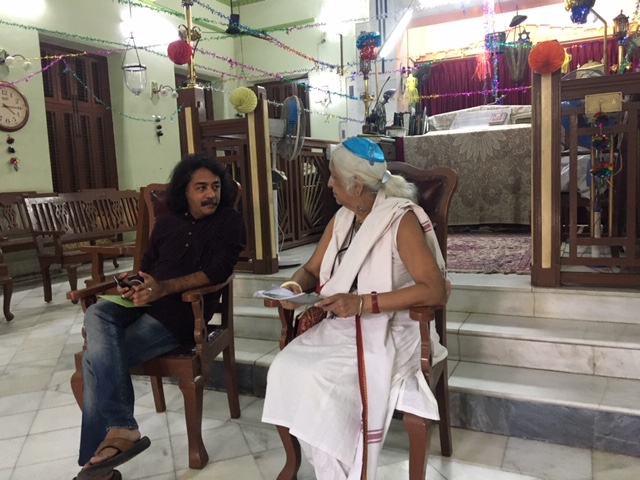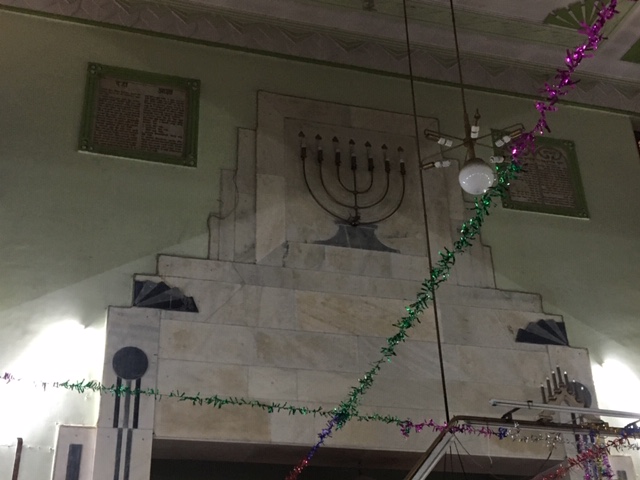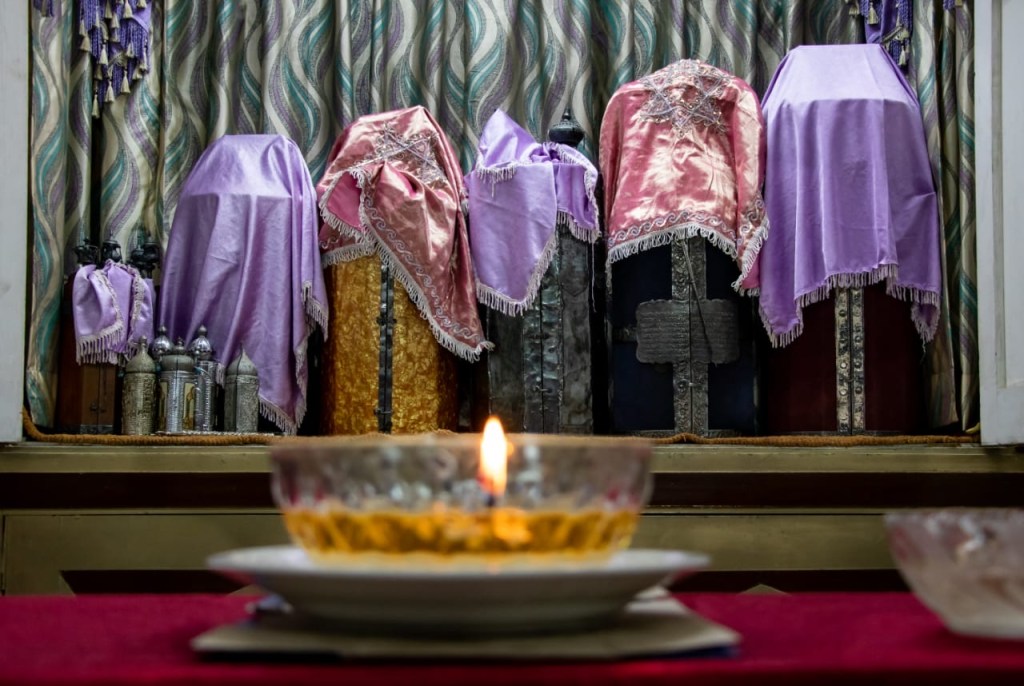I have been visiting the Synagogue at Cochin (Kochi now) since childhood. Located on the island of Kochi it has an intriguing old world charm. In all these years in Ahmedabad I was unaware that there was a Synagogue here in the old city, the Magen Abraham Synagogue. Shutterbugs, the Student Photography Club at Ahmedabad University, organized a visit and discussion on the Jewish presence in Gujarat where we enjoyed a guided tour and a fascinating conversation on the topic with Esther David, one of the 140 Jews still resident in Ahmedabad.. The Jews are a dwindling population in India since the creation of the Promised Land Israel.


Before going on the visit I did my homework like a good researcher! I discovered we had a book in our own home library by Benjamin J. Israel, ‘The Jews of India’, Mosaic Books, New Delhi (1982 reprinted in 1998 and 2001). A lot of the conversation with Esther was actually recorded in this book, which appeared to be a treatise on the Jews in India.
When we visited Jerusalem, on our trip to Israel, we were aware that the origins of the three great religions of the world was on that holy land. https://jeemolunni.com/2018/12/23/the-magical-holy-land-a-fusion-of-cultures/ In our conversation at the Synagogue and subsequent internet searches the importance of Prophet Moses and Abraham for all the three religions became clear.
Story of Prophet Moses: At the time of Moses, 13th to 14th century BC, the Jews were enslaved in the Kingdom of Egypt. Moses was adopted by the Pharaoh’s daughter (or wife) and grew up in the royal palace. He fled the country and encountered the burning bush, the Menorah, which is now a symbol of Judaism. God spoke to him and asked him to go back to Egypt to release the enslaved Israeli people and lead them to the Promised Land. Moses led the Exodus of Israelis across the Red Sea to Mount Sinai where he was given the Ten Commandments engraved on a stone. Moses and the people wandered in the wilderness for forty years but Moses died on Mount Nebo overlooking the Promised Land, but before entering it. https://en.wikipedia.org/wiki/Moses

Story of Prophet Abraham: Abraham lived in Canaan and was in search of the ‘Promised Land’ for his people as promised to him by God. But he and his wife Sarah had no children. So he married the Egyptian maid Hagar and had a son, Ismael, first-born son of Abraham. Later his wife Sarah had a son Isaac. Abraham nearly sacrificed Isaac, on God’s bidding, but was stopped by him as he proved his faith. Abraham finds a ram stuck in a bush and sacrifices the ram.
All the three religions that grew out of this land have a prominent place for Prophet Abraham. https://jeemolunni.com/2019/02/10/in-turmoil-layered-tensions-in-the-holy-land/ In our earlier trip to Tel Aviv we noticed a set of three photos of people named Abraham who were Christian, Jew and Muslim. What a wonderful way to depict the mixing of cultures in this region! https://jeemolunni.com/wp-content/uploads/2019/02/c671d-img_1508.jpg
The Christian religion links Abraham’s near sacrifice of his son to the later sacrifice of Christ, ‘the only begotten son of God’ for the sins of the world. In the New Testament, John the Baptist saw Jesus coming toward him and said “Look, the Lamb of God, who takes away the sins of the world!” (John 1:29) https://en.wikipedia.org/wiki/Binding_of_Isaac
Ismael, son of Abraham and Sarah, is seen as the prophet and ancestor to Prophet Mohammad. He is also associated with Mecca and the construction of Kaaba. His descendants were known as Ishmaelites from which Islam may be said to originate. https://en.wikipedia.org/wiki/Ishmael_in_Islam
Abraham’s son Isaac married Rebecca and had a son Jacob, also known as Israel. Jacob begot 12 sons from his four wives/concubines. The descendants of these twelve sons are know as the twelve tribes of Israel. Two of the tribes from his sons Judas and Benjamin formed the Kingdom of Judah in the South, including the city of Jerusalem. Jesus is thought to be from the lineage of Judah. The other ten tribes formed the Kingdom of Israel in the North.
In the 7th Century BC the Ten Tribes were said to have been deported from the Kingdom of Israel during the conquest by the Neo-Assyrian Empire. The Kingdom of Judah in the South was seized by Babylon and these two tribes were also exiled, but later allowed to return. These two tribes thus retained the essence of Judaism.
Jews in India: There are three segments of Jews in India all tracing their arrival at different times and through different routes. These are the Bene Israelis, Cochinis and Baghdadis. The Cochinis , with their synagogue in Fort Cochin, is said to have come from different places including Egypt, Syria, Turkey, Iran, Iraq, Spain, and even Germany at various times between the 13th and 18th centuries AD. However, there are mentions that the Cochini Jews may have been here from the time of the two apostles of Christ who came to India around 30 AD, St. Thomas and St. Bartholomew! The Cochini Jews also maintained their links with Jews in Egypt, Syria, and are also said to have been encountered by Marco Polo during his visit in the 13th century. They thus retained most of the traditional customs, teachings, and read the Torah, spiritual text, in Hebrew. The main synagogue in Cochin is know as the “Pardeshi” (foreigner) Synagogue and was built by the latest immigrants in 1568). (Benjamin Israel, ‘The Jews of India’)
The Bene Israelis are said to have landed in a shipwreck in Navagaon, along the coast of Maharashtra, about 20 miles south of the Bombay Island in the 13th century. According to tradition only 7 men and 7 women survived the shipwreck. The number 7 probably only meant a few survived and 7 is considered a holy number. They settled in the Konkan region of Maharashtra and the Bene Israelis are considered the descendants of these 7 couples. The Bene Israelis mingled well with the Indian population and took the names of the various villages they settled in with the suffix ‘kar’, broadly meaning ‘from’. They adopted and spoke the local language. They did not retain much of the Jewish tradition, except circumcision and the Saturday Sabbath. They took to the local trade as oil pressers and hence came to be known as the ‘Shenwari Teli’ or the Saturday oil pressers! They did not read the holy text and only knew the work ‘Shema’ meaning ‘hear’ in Hebrew, the most solemn declaration of faith which is uttered repeatedly in the Synagogue. This leads to the claim that these Jews belong to the ‘Ten Lost Tribes’ of the Israelis. Tradition has it that one David Rahabi, son of Ezekiel Rabhani, a famous Cochini Jew, came to Konkan and instructed the Bene Israelis in the Jewish religion and its practices and trained instructors in the Jewish religion. (Benjamin Israel, ‘The Jews of India’)
The third segment consist of Jews from West Asia, mainly from Baghdad, who came as traders around the 19th century. They came from Basra, Syria, Aden, Iran and Afghanistan. They are settled mainly around Calcutta and Bombay. They spoke Arabic and Persian and later English, but never adopted the Indian languages.
Jews in Gujarat: The Jews in Gujarat and Ahmedabad, claim to be Bene Israelis belonging to the tribe of Zebulum, one of the Ten Lost Tribes. They came to Ahmedabad with the British, during the British Empire in 1857. Originally one family of Jews settled in Pankornaka and build a small Prayer Hall. They donated the land on which the Megan Abraham Synagogue was built. The synagogue is build in a Indo Judaica Art Deco style, with both Judian and European influence. The main entrance has a grill in the shape of a Menorah. It has a high roof with no pillars in the central hall, which remains a curiosity for architects till date. It has a woman’s gallery upstairs, and Esther David remembered that her grandmother would bring them to the synagogue every Sabbath and they would be seated in the woman’s gallery. Now with the depleted Jewish population of 140, men and women are seated in the central hall, but on separate sides.

Johnny bhai (meaning brother) manages and maintains the Megan Abraham Synagogue. It contains the Torah, the Five Books of Moses, the Holy scriptures, preserved beautifully in metal covers in a large closed cupboard behind a screen. We would never have known if Johnny bhai had not given us a special viewing of the sacred texts and an introduction to it. It is written in black ink in Hebrew on scrolls of parchment made of sheep skin. It requires that 10 men above the age of 13 should be present when the Torah is read. There are no woman Rabbis in India.

The Torah parchment is written in Hebrew with no vowels. The five books are read through the year. The last para of the last book is completed on the day before New Year and the reading of the new Book also begins. If on any day 13 men are not available the text is not read. While one person reads the text from the scroll, another checks in another book where it is written in Hebrew with vowels, to make sure that the reading is correct. So we were told by Johnny bhai. The Torah is also read in English and Marathi.

On Friday night before Sabbath, the Jewish community meets in the synagogue. They light a lamp, drink black current sherbath (juice), as wine is not permitted in the state, break bread and offer prayers. Nearly 30 percent of the 140 Jews in Ahmedabad are below the age of 13 years. Jews have minority status in India. Earlier all the Jewish families lived in one line from the Synagogue up to Shahibaug area in the old city. Now they are dispersed and live throughout the city. There are seven Jewish run schools in Ahmedabad which provide good quality schooling to children of all communities.
The traditional Jews only eat Kosher foods. Any meat food cannot be eaten in the same meal with any dietary product, like milk, buttermilk or yogurt. After eating meat you have to wait for a period of time before consuming any dairy product. To overcome this dietary restriction, the Jews of Konkan region used recipes where meat is cooked with coconut milk. Not sure this is a Jewish invention as this is a regular recipe in states with large coconut plantations, like Kerala, Karnataka and Maharashtra in the Western coast of India. And this is where the Jews settled first in India!
And so ended the most enlightening and refreshing two hours in the Megan Abraham Synagogue with Esther David and members of Shutterbug, the student Photography Club of Ahmedabad University, Ahmedabad.



jeemol maam…its a wonderful articulation…i need to learn this art from you:))
LikeLike
Hello Jeemol, a very enlightening article indeed! Thank you for sharing.
LikeLike
Hello Jeemol! a very enlightening article indeed. Thank you for sharing.
LikeLike
What a beautiful post! I just posted about the Bene Israel community in my post about the two synagogues in Pune too. 🙂
LikeLike
Thank you Anmol. Will look up your posts
LikeLiked by 1 person